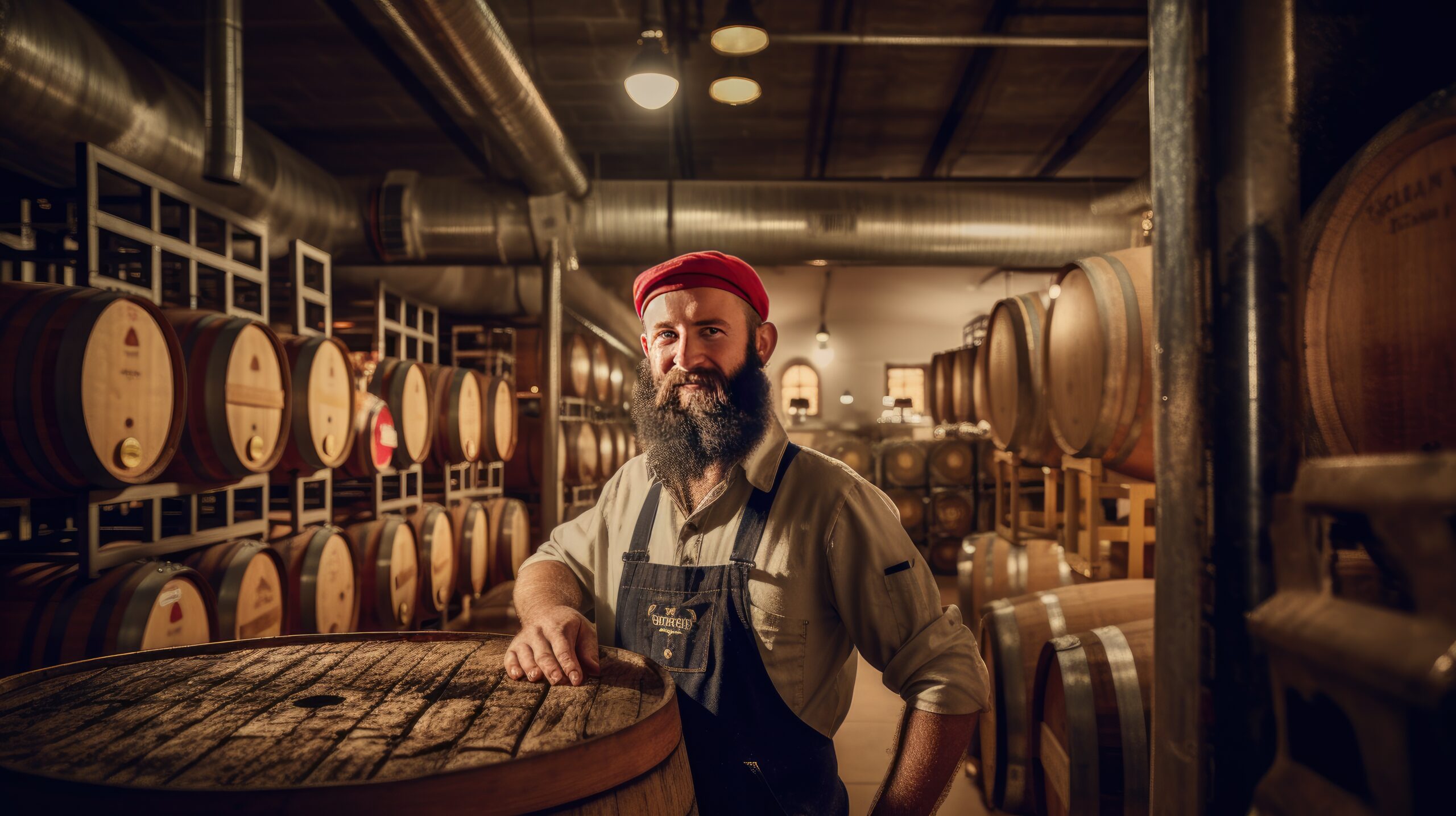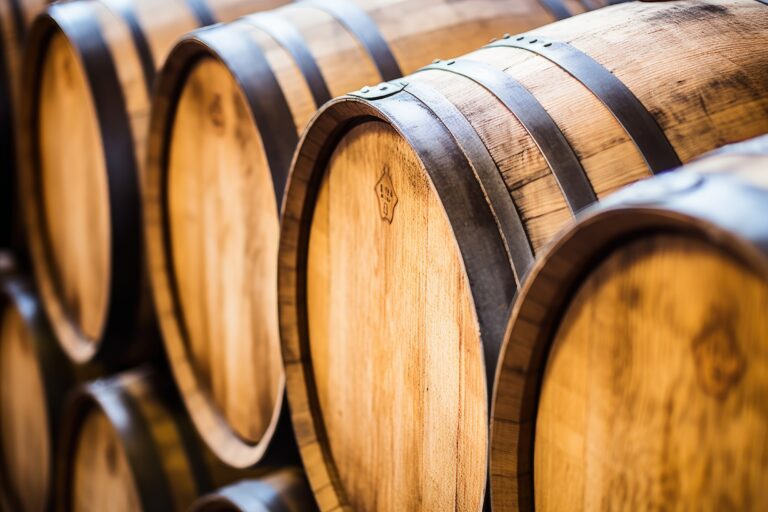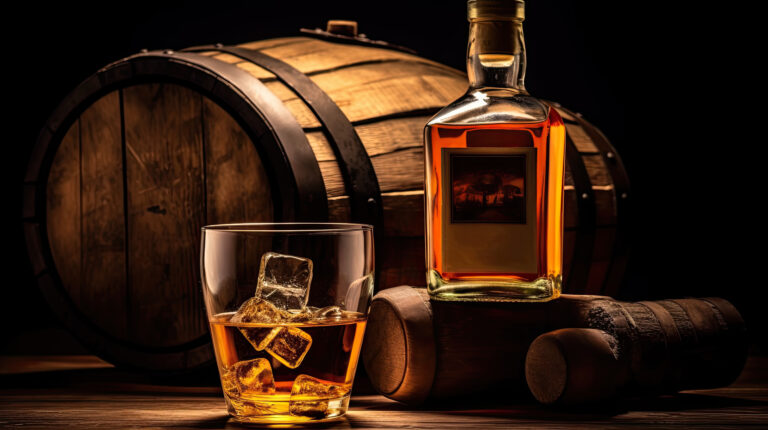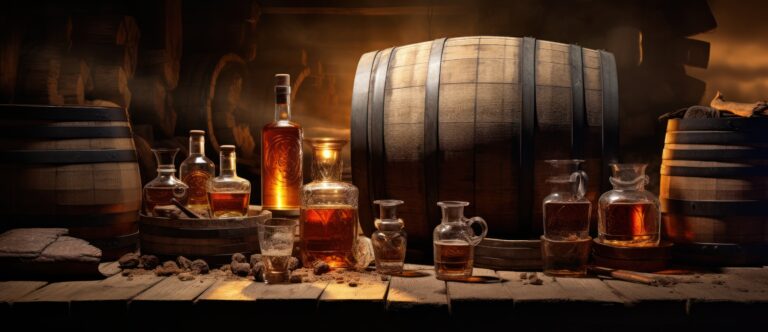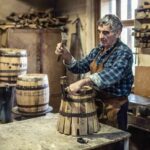You know, it’s kind of amazing how much the wood influences a good dram, isn’t it? You can have the same grains, but the whiskey barrel wood makes all the difference in the taste. Think about it – those notes of caramel, vanilla, and spice you love? They come straight from the charred oak barrels, not just the grains themselves. The type of oak and where it’s grown really shapes the whiskey’s aroma and taste.
So, next time you’re enjoying your favorite whiskey, take a moment to appreciate the wood that made it happen. That hint of clove in your bourbon, the touch of honey in your Scotch, or the dried fruit in your rye – that’s all thanks to the barrel. Honestly, whiskey wouldn’t be the same without the barrel, and the barrel’s characteristics are all about the wood.
What Makes Whiskey Barrel Wood Unique?
The wood used for whiskey barrels, most often American white oak, has a huge impact on the flavor of the aged spirit. Here’s what makes it so special:
- The type of oak and its origin: Just like grapes for wine, the variety of oak and where it grew matters. American white oak from the Ozark Mountains will lend different notes than oak from the Appalachians. The climate, soil, and growing season all play a role in the wood’s characteristics.
- The age of the harvested tree: Older trees tend to have denser wood with fewer tannins, which can lead to smoother, spicier whiskeys. Younger wood is often more porous, potentially resulting in fruitier flavor profiles.
- The wood’s natural compounds: This is where the magic happens.
- Lignins break down into those lovely vanilla flavors.
- Tannins contribute spice notes like clove or nutmeg and are important for aging.
- Lactones can give hints of coconut or almond. The wood’s chemistry directly influences the whiskey’s aroma and taste.
- The barrel’s char or toast level: Think of this like roasting coffee beans. More intense heating brings out caramel, chocolate, and even coffee flavors. Lighter toasting tends to produce brighter fruit and citrus notes. The char also creates lots of surface area where flavor compounds can really develop.
- Location within the distillery: Believe it or not, where the barrels are stored makes a difference. Those on upper floors or near windows experience more temperature fluctuations, which can speed up the chemical reactions between the wood and the spirit, affecting how quickly the whiskey matures and gains complexity.
Ultimately, the wood and the whiskey have this amazing relationship. The natural compounds and the porous nature of the oak enhance the distilled spirit’s own flavors over years of aging. Barrel wood truly makes whiskey a unique and sensory experience.
The Science Behind Whiskey Barrel Aging
The aging process is where whiskey really finds its soul, developing its distinctive flavor and aroma. During this time, the whiskey extracts compounds from the wood, giving it those sought-after vanilla and caramel notes. But the wood itself has its own story to tell.
The Wood Source Matters
The type of oak and where it’s grown have a big impact. American white oak is a go-to choice. Oak from the central US, with its contrasting hot summers and cold winters, tends to have tighter growth rings. This means the whiskey has more contact with the wood as it ages, leading to more flavor being imparted. European oak, on the other hand, often has wider rings, which can result in lighter flavors. And Japanese oak? It often falls somewhere in between.
- American oak barrels are often used for bourbon and rye whiskeys, contributing vanilla and spice notes.
- European oak barrels frequently lend fruitier, nuttier flavors to whiskeys.
- Japanese oak can even provide delicate floral aromas.
The Barrel’s Toast Level Influences Flavor
That interior char or “toast” level of the barrel is another key player in the taste. Lightly toasted barrels might give you subtler oak and spice notes. Medium toast often brings out more caramel and vanilla. And a heavy toast can lead to whiskeys with chocolatey, smoky flavors.
Think about it – the location where the oak grew, how it was cut and milled, and how the barrel was put together and charred – all of these details come through in the final product. A true artisanal whiskey maker considers all these nuances to create a spirit that’s as unique as the place it was made. There’s definitely real science behind the wood that gives whiskey its character.
How Grain Impacts Flavor
Beyond the wood of the barrel itself, the type of grain used to make the whiskey has a significant impact on the final flavor. Barley, wheat, rye, and corn are common choices, and each brings its own unique characteristics to the spirit.
Barley
Barley is a star player, especially in Scotch and Irish whiskey. It gives the spirit a smooth, malty flavor with hints of nuts, toast, and caramel. The popularity of barley is what really established iconic whiskeys like scotch and Irish whiskey.
Wheat
Wheat finds its way into whiskey barrels in Scotland, Ireland, and America. It contributes a light, sweet flavor with notes of vanilla, honey, and even a touch of citrus. It’s a key ingredient in bourbon and is valued for creating a milder, more approachable spirit. Wheat whiskey often appeals to those who find the robust, spicy flavor of rye a bit too intense.
Rye
Rye grain was a staple in early American whiskeys and is still loved today. It packs an assertive, spicy punch with notes of cinnamon, clove, and black pepper. Rye whiskey has an intensity that really holds its own in cocktails. You’ll find it in Canadian whisky, American rye whiskey, and even German kornbrand.
Corn
Corn is the heart and soul of American bourbon whiskey. It gives bourbon that mellow, buttery flavor with undertones of corn, nut, and oak. By law, bourbon must have at least 51% corn in its mash bill. This high corn content is what truly sets bourbon apart from other American whiskeys.
And it’s not just the type of grain – the location and environment where the grains are grown also have an effect. Differences in climate, soil, and even the harvest method can influence the flavor compounds that develop in the grain and eventually make their way into your whiskey. These variations in grain type and origin are a big part of why whiskey from different regions of the world is so distinctive.
Where the Barley Grows Matters
Just like with the oak, the region where barley is grown has a significant impact on the flavor of whiskey. Barley absorbs characteristics from the soil, water, and climate where it’s planted. These environmental factors, often referred to as terroir, influence the grain’s chemical makeup, and that carries through to the distilled spirit.
Scotland
Scotland’s cool, maritime climate and diverse soil types create barley that’s just right for making single malt Scotch whiskey. The barley often has a rich flavor thanks to the mineral-rich soil and the salty sea air. Whiskeys made from Scottish barley frequently have notes of honey, nuts, and dried fruit.
Ireland
Ireland’s barley is also highly regarded for whiskey production, particularly in areas like County Cork and County Kilkenny. The mild, rainy climate and fertile soil yield barley with a lightly sweet, malty flavor. Irish whiskeys tend to be smooth, creamy, and floral.
United States
Several regions in the U.S., including Washington, Oregon, and upstate New York, are gaining recognition for growing barley well-suited for craft whiskey. The terroir varies, but it often produces grain with an earthy, spicy character. American single malt whiskeys are becoming known for being bold, complex, and diverse.
So, where the barley comes from really does have a profound impact on a whiskey’s taste and aroma. As more distilleries experiment with locally-sourced grains, we’re seeing even more opportunities to explore the subtle nuances of place. Trying whiskeys made from barley grown in different regions is a fantastic way to discover how terroir translates into the finished spirit. The location of the barley is a big deal when it comes to the final flavor profile of the whiskey.
The Oak Tree’s Environment Influences Taste
It’s not just about the type of oak; the environment where an oak tree grows also significantly impacts the flavor compounds that develop in the wood. Everything from the weather it experiences to the soil conditions where it’s rooted influences the taste of the barrels made from its wood.
Weather Conditions
Hot, sunny weather can cause the oak to produce more tannins as a way to protect itself from the elements. More tannins in the wood can lead to a barrel that imparts bolder, spicier flavors to the whiskey. On the other hand, oak grown in cooler areas with less intense sunlight tends to produce wood with fewer tannins, which can result in barrels that lend lighter, sweeter notes.
Soil Nutrients
The nutrients present in the soil where an oak tree grows also affect the wood’s chemical composition and ultimately its flavor. Oak grown in soil richer in nutrients like calcium or magnesium might yield barrels that contribute flavors reminiscent of vanilla, coconut, or even chocolate. Less fertile soil might result in wood dominated by spice or clove-like flavors.
Mineral Deposits
The presence of certain minerals in the soil and water surrounding the oak can also find their way into the wood, subtly influencing the whiskey’s flavor. For instance, oak grown in areas with more iron in the soil and water might produce barrels that impart notes of cherry or almond. Similarly, oak from regions with higher concentrations of sodium might yield barrels lending salty or briny nuances.
Growth Location
The specific location where an oak tree is grown, often referred to as provenance or terroir, has been shown to significantly impact how the barrel affects the taste of the whiskey. For example, whiskey aged in barrels made from oak grown in the Ozark Mountains of Missouri frequently exhibits honey and pecan flavors, while oak from Minnesota more often contributes floral notes like violet. Barrels made from Kentucky oak are highly prized for imparting those classic bourbon flavors like vanilla, caramel, and spice.
Ultimately, the environment in which an oak tree grows helps determine the unique chemical fingerprint of its wood and the resulting flavor signature of the barrels made from it. By understanding how factors like weather, soil, minerals, and location influence the oak, distillers can carefully select barrels tailored to produce a specific flavor profile in their whiskeys.
Why American Oak Stands Out
American oak, particularly white oak (Quercus alba) and red oak (Quercus rubra), is highly valued for aging whiskey and imparting its distinctive flavor notes. Its tight grain and medium porosity allow for a gradual and beneficial interaction between the wood and the spirit.
Location Matters
American oak grown in the central U.S., including states like Missouri, Kentucky, and Tennessee, is especially prized for barrel making. The climate in these regions tends to produce wood with an ideal moisture content and density for barrels. Wood from more southern regions can sometimes be too porous, leading to spirit loss, while wood from northern areas might be too hard and impart a bitter taste.
Slow Growth Is Key
Tightly spaced growth rings in the wood are a good sign. They indicate that the tree grew slowly, resulting in denser wood. Wider rings suggest faster growth and wood that might be more prone to leaking. This slow-grown wood has had more time to develop the compounds that will eventually impart flavor to the aging spirit.
Char Level Influences Flavor
The level of char on the inside of the barrel is a critical factor in how much flavor is transferred to the whiskey. A light char often yields notes of vanilla and caramel, while a heavier char can produce smoky, spicy flavors. Master distillers carefully control the char level to achieve the specific flavor profile they’re aiming for.
Oak Compounds Enhance Aroma and Flavor
The wood itself is full of compounds that contribute to the whiskey’s character. Lactones in the wood can give whiskeys aromas of coconut and vanilla. Phenols contribute spicy and smoky notes. Furfural can provide an almond-like aroma. These compounds gradually migrate into the spirit over years of aging, enhancing its aroma, flavor, and even its mouthfeel. This slow interaction between the wood and the spirit is what gives fine whiskeys their complexity.
The combination of American white oak and longer aging times has made U.S. whiskeys renowned around the world. By understanding the factors that influence the barrel’s impact on flavor, you can gain a deeper appreciation for the artistry involved in producing an exceptional bourbon or rye whiskey. Cheers to that!
The Importance of Grain Orientation
The way the wood grain is oriented in whiskey barrels plays a significant role in how the flavor develops as the whiskey matures. As the liquid ages, it soaks into the wood, absorbing compounds that contribute to its aroma and taste. The direction of the grain influences just how much liquid can penetrate.
Tight Grain
Wood with a tight, straight grain, often found in oak from Northern Europe, has dense fibers packed closely together. This makes it more challenging for the whiskey to soak deeply into the wood, leading to a more gradual absorption of flavor compounds. The result is often a smoother, mellower flavor profile. Many distillers prefer tight-grained oak for aging lighter spirits.
Loose Grain
In contrast, wood with a loose, more irregular grain, like American white oak, has more open space between the fibers. This allows the whiskey to penetrate more rapidly, extracting more robust flavors like vanilla, caramel, and spice. The looser grain can also allow for greater oxidation, which can accelerate the aging process. Many bourbon distillers favor loose-grained oak because it can yield bold, distinctive flavors in a shorter amount of time.
The location where oak trees grow also affects the grain. Trees grown in dense forests generally develop tighter grain as they grow taller and straighter to reach sunlight. Trees in more open areas tend to develop looser grain, often with more knots and irregular shapes. The climate, soil conditions, and available nutrients in a region can all influence the oak grain.
Whiskey makers consider many factors when selecting barrels, but grain orientation is definitely one of the most important. By understanding how wood grain influences flavor, you can better appreciate why certain whiskeys achieve their distinctive aromatic and taste profiles. The next time you’re sipping an aged spirit, take a moment to consider how the wood it was aged in might have shaped your experience.
Coopering Traditions Create Nuanced Barrels
Coopering, the time-honored craft of barrel making, has been practiced for centuries. Skilled coopers use traditional techniques to craft oak barrels that are ideal for aging whiskey. Their work is absolutely essential in developing the distinctive flavors of barrel-aged spirits.
- The type of oak used, whether it’s American white oak or European oak, has a direct impact on flavor. American oak tends to impart more vanilla and coconut notes, while European oak often brings spice and dried fruit accents.
- The grain of the wood also plays a crucial role. Tightly grained wood allows for less interaction with the whiskey, leading to subtler flavors. Looser grain provides more surface area for the whiskey to extract compounds from the wood, resulting in bolder flavors.
- The location where the oak trees grew influences the flavor compounds they develop. Oak grown in warmer climates often has more robust, intense characteristics compared to oak from cooler areas. Terroir, a term often used for wine, applies to wood as well, referring to the environmental factors that affect agricultural products.
- The coopering techniques themselves, such as how the staves are cut and how the barrels are toasted and charred, significantly impact flavor. Heavier toasting and charring will lead to more pronounced flavors of caramel, chocolate, and smoke. Lighter treatments allow the natural oak flavors to shine through.
- The barrels are vital for the whiskey to mellow and mature. As whiskey ages in the barrels, it expands and contracts with seasonal temperature changes, seeping into the wood and then drawing flavor compounds back out. This interaction, often called the “breathing” of the barrels, is essential for developing complex aromas and tastes.
The coopers’ craft, often passed down through generations, blends artistry with scientific precision. Their traditional techniques and deep understanding of how wood and whiskey interact are fundamental in creating some of the world’s most celebrated aged spirits. The nuanced barrels they produce are the very first step in crafting a truly delicious dram.
Whiskey Barrel Wood FAQs
Lots of folks have questions about whiskey barrel wood and what factors influence the flavor of the whiskey. Here are some of the most common questions about barrel wood.
What type of wood is used for whiskey barrels?
The most common types of wood used for whiskey barrels are American white oak (Quercus alba) and European oak (Quercus robur). American white oak is a favorite for bourbon whiskey barrels because of its more porous structure, which allows for better flavor infusion.
Does the oak grain affect the flavor?
Absolutely! The grain of the oak wood has a significant impact on the flavor. Tight-grained wood leads to a slower infusion, resulting in smoother, mellower flavors. Loose-grained wood, with its more open pores, allows for faster infusion and bolder, spicier flavors. Distillers can strategically choose barrels with different grain tightness to achieve their desired flavor profile.
Does the oak growth location matter?
Yes, the location where the oak trees are grown, also known as provenance or terroir, plays a role in the final flavor. Oaks grown in different regions and climates will naturally have variations in their composition, density, and the flavors they can impart. For example, American white oaks from the Ozark Mountains and Appalachians are commonly used for bourbon, while European oaks from Spain, France, and Eastern Europe are often chosen for Scotch whisky.
How are barrels toasted and charred?
Barrels undergo toasting by exposing the inside to heat, which helps to develop flavor compounds in the wood. The level of toasting, ranging from light to heavy, influences how many of these flavor compounds are extracted. Following toasting, barrels are often charred by burning the inside. This charring creates layers of carbonized wood that contribute additional flavor, color, and aroma compounds. The depth of the char, from a light singe to a deep “alligator char,” significantly impacts the final whiskey.
How long are barrels used?
Whiskey barrels typically have a useful lifespan for aging spirits of around 3 to 5 years, though they can sometimes be used for longer periods, up to 10 years or even more. Over time, the barrels gradually lose some of their ability to impart strong flavors. However, they still allow for important interactions like oxidation. Once barrels become too neutral or porous, they are often retired from whiskey making but can find new life in other applications.
Final Thoughts
So, there you have it – a deeper look into how the whiskey barrel wood, influenced by different grains and growth locations, shapes the flavor and aroma of the aged spirit. The next time you savor a glass of bourbon or Scotch, take a moment to appreciate the incredible role the wood played in creating that experience. It’s truly remarkable how nature’s simple elements of wood, water, and grain can come together to produce such complexity. Whiskey is undeniably a product of its environment. Now that you have a better understanding of the secrets behind whiskey barrel wood, you can surely appreciate why distillers go to such great lengths to source the very best barrels. And for us enthusiasts, it gives us even more insight into why certain brands or types of whiskey resonate so deeply. Here’s to uncovering more of the fascinating mysteries held within the wood that helps transform distilled spirit into the delicious whiskey we all enjoy.
